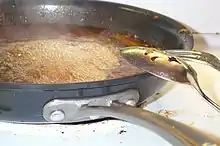
In cooking, reduction is the process of thickening and intensifying the flavor of a liquid mixture, such as a soup, sauce, wine or juice, by simmering or boiling.[1]
Reduction is performed by simmering or boiling a liquid, such as a stock, fruit or vegetable juice, wine, vinegar or sauce, until the desired concentration is reached by evaporation. This is done without a lid, enabling the vapor to escape from the mixture. Different components of the liquid will evaporate at slightly different temperatures, and the goal of reduction is to drive away those with lowest points of evaporation.
While reduction does concentrate the flavors left in the pan, reducing too much will drive away all liquid in the sauce, leaving a "sticky, burnt coating" on the pan.[2]
Sauces, ranging from basic brown sauce to Béchamel sauce and even tomato sauce, are simmered for long periods (from 1 to 10 hours) but not boiled. Simmering not only develops the maximum possible flavor, but also allows impurities to collect at the top and be skimmed off periodically as the sauce cooks. Boiling would diffuse the impurities into the liquid and result in a bitter taste and unclear stock.[3] Broths are also simmered rather than boiled, and for the same reasons.[3]: 304–5
Examples
Common preparations involving reductions include:
- Consommés, reduced and clarified stocks
- Gravies
- Gastriques, sauces involving both acidic and sweet components
- Pan sauces
- Syrups
References
- ↑ "Technique: Making a Sauce Reduction". The Kitchn. Retrieved May 29, 2015.
- ↑ Petrosky, Maureen C. "How To Make A Reduction". Food Republic. Retrieved May 29, 2015.
- 1 2 The Culinary Institute of America (2011). The Professional Chef (9th ed.). Hoboken, New Jersey: John Wiley & Sons. pp. 268-70 (brown sauce), page 295 (Béchamel Sauce and Tomato Sauce). ISBN 978-0-470-42135-2. OCLC 707248142.